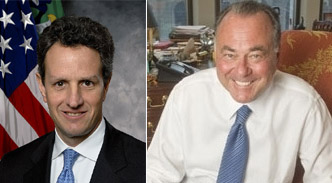 |
Real estate experts had a generally positive view of U.S. Treasury Secretary Timothy Geithner’s plan, unveiled yesterday, to encourage private investors to buy up troubled loans and securities with federal loan guarantees, but remained cautious that workouts for many complex securities were not addressed.
Richard Baxter, executive vice president at Cushman & Wakefield, said although it was too early to know how New York City commercial real estate values would be affected, the plan was likely to be beneficial.
“It does bode well for troubled development deals and loan maturities on office buildings. The credit markets have been shut down for nearly 20 months and any good news is welcome,” he said via e-mail.
The first part of the two-pronged plan is known as the Legacy Loans Program, and is aimed to remove distressed loans from the balance sheets of lending institutions. The second part, the Legacy Securities Program, provides for the purchase of troubled securities from banks.
Stephen Siegel, chairman at CB Richard Ellis, said the plan should have a positive effect, in part because it keeps the assets in the hands of investors who have an interest in their economic success.
“The requirement that they have ‘skin’ in the game is an important component. It will keep the properties out of the hands of the, ‘Why-not-take-a-chance-it-costs-nothing’ speculators,” he wrote in an e-mail.
It was unclear what short-term implications the move would have on distressed assets held by lenders today, Robert Knakal, chairman of Massey Knakal Realty Services, said, but added that he expects the plan to increase liquidity in the market.
“To the extent the plan creates credit … it should have a positive effect on the value of the assets whether [they are] distressed or not,” Knakal said.
He did not believe distressed sales were being held up by buyers and sellers waiting for the government’s plan to take hold.
“I am not aware of anyone who specifically told me that. A lot of distressed assets, either note sales or property sales, are in a very clogged up pipeline,” caused in part by a drawn out foreclosure process, he said.
Tom Fink, managing director at Trepp, said the plan did not directly impact troubled commercial loans held in commercial mortgage backed securities, or CMBS. For example, it does not provide a way to purchase securitized loans for developments such as Stuyvesant Town-Peter Cooper Village on the East Side and Riverton Houses in Harlem that are not generating enough in rental income to support mortgage payments.
It does offer investors a pathway to purchase bonds held in the CMBS packages, Fink said, but he did not believe that would have a direct impact on the underlying loans, many of which remain non-performing.
Norman Radow, president and CEO of Atlanta-based development and workout firm Radco Companies, which is expanding its operations to New York City, said the complexities of some of the securitized assets make such workouts difficult.
“Securitized debt and other exotic financial vehicles are a significant part of the assets being held up on balance sheets,” he said. “Who decides the value? I think there will be a lot left to be decided.”
But the plan announced yesterday was a step toward turning the market around, he said.
“Even if there are huge discounts and lots of assets are thrown at once [into the market], the healing will begin,” Radow said.